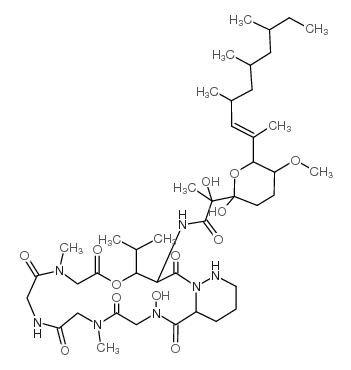| In Vitro |
ATP6V1G, a subunit of the vacuolar H+-ATPase (v-ATPase)[3]. Verucopeptin (0-30 μM; 72 h) shows excellent antitumor activity against K562R cells, with an IC50 of 388 nM, although these cells exhibit resistance to some other chemotherapeutic agents, such as Taxol and vincristine at concentrations of 10 μM[3]. Verucopeptin (0-1 μM) shows broad antiproliferative activity, with IC50 values of less than 100 nM against 66% of the cell lines evaluated among a total of 1,094 cancer cell lines. Moreover,Verucopeptin displays tissue specificity, such as leukemia, lymphoma, and melanoma, are classified in the lower IC50 groups, while the higher IC50 groups including other cancer types, such as non-small cell lung cancer[3]. Verucopeptin (10 nM; 1 hour) pretreatment blocks VE-P labeling of ATP6V1G1 but not ATP1V1B2 or ATP6V1D in a competitive binding assay. Verucopeptin shows substantial inhibition of v-ATPase activity and suppresses lysosomal acidification in vitro, as does Baf A1, although to a lesser extent[3]. Verucopeptin (0-500 nM; 1 hour) exhibits substantial inhibition of p-S6K as well as p-4EBP1 at concentrations of 10-200 nM. Additionally, Verucopeptin attenuates the phosphorylation of most of the tested mTORC1 downstream substrates, including p-4EBP1, pmTORS2448, p-mTORS2481, p-Rictor, p-ULK1, and p-Grb10, at concentrations ranging from 50 nM to 500 nM[3]. Verucopeptin (0-335 nM; 24 hour) decreases the HIF-1 protein level in a dose-dependent manner but has no effects on c-Raf in HT1080 cells. However, the known hsp90 inhibitor Tanespimycin (HY-10211) inhibits both HIF-1 and c-Raf expression in cells[2].
|
